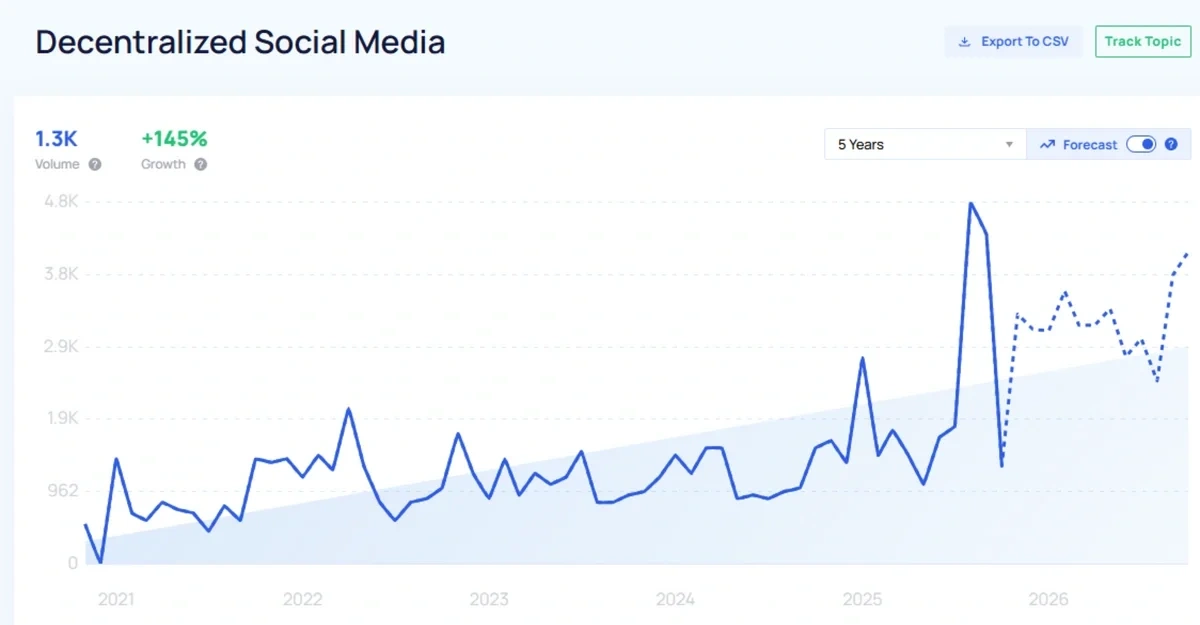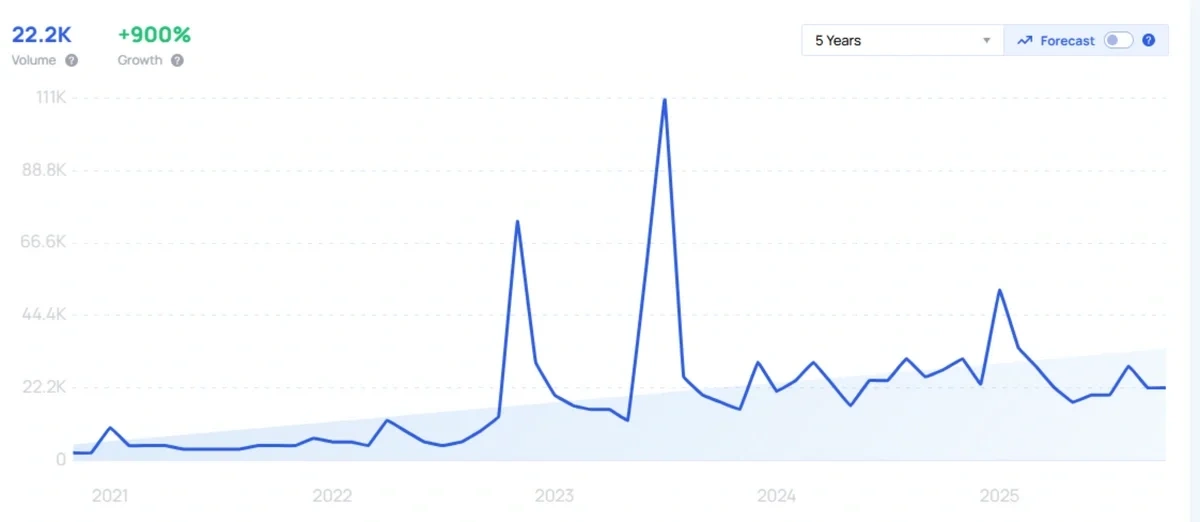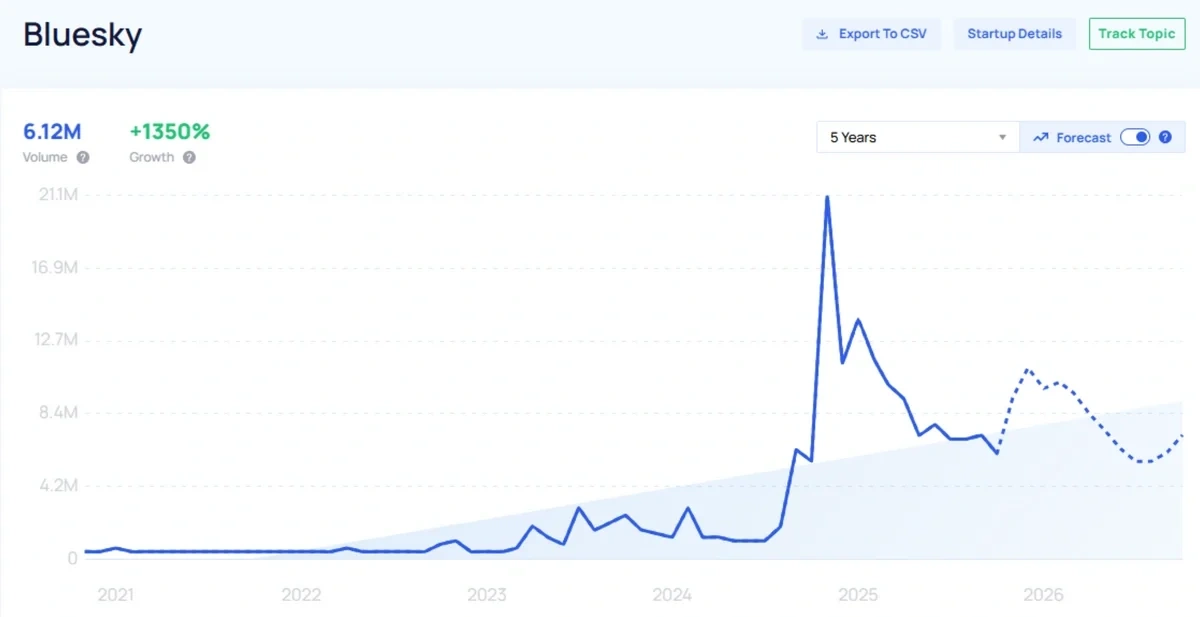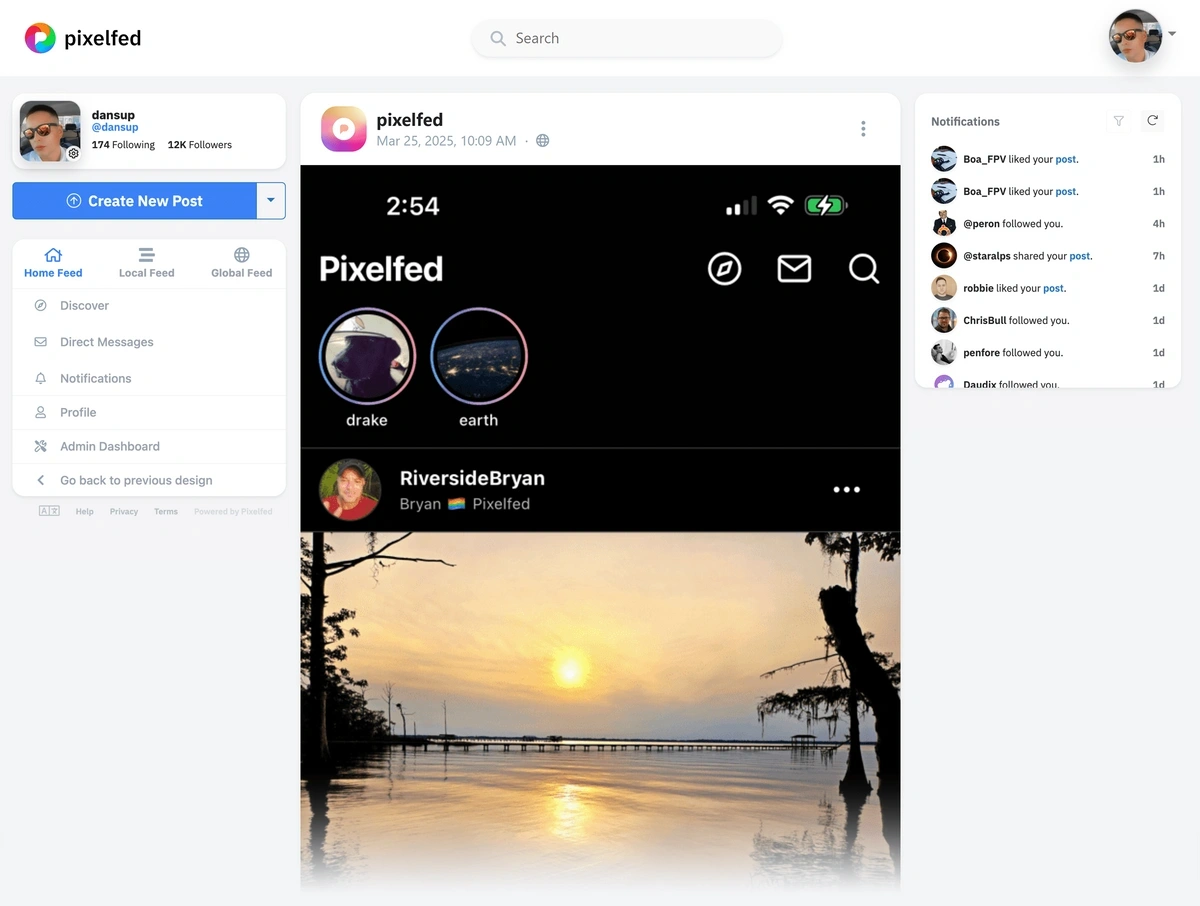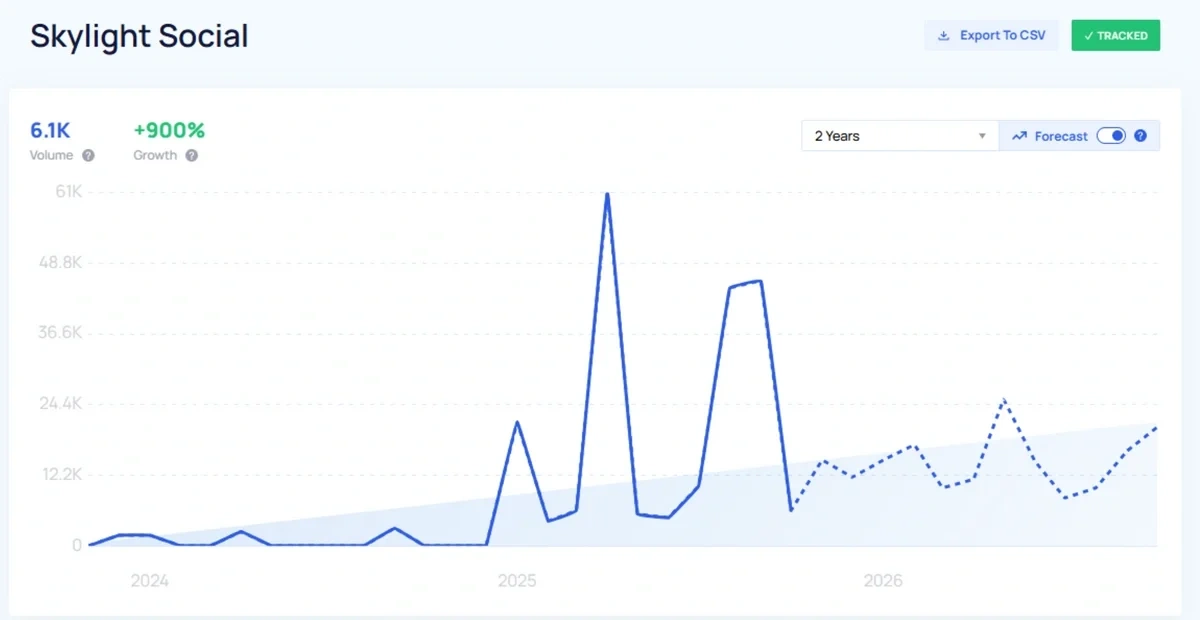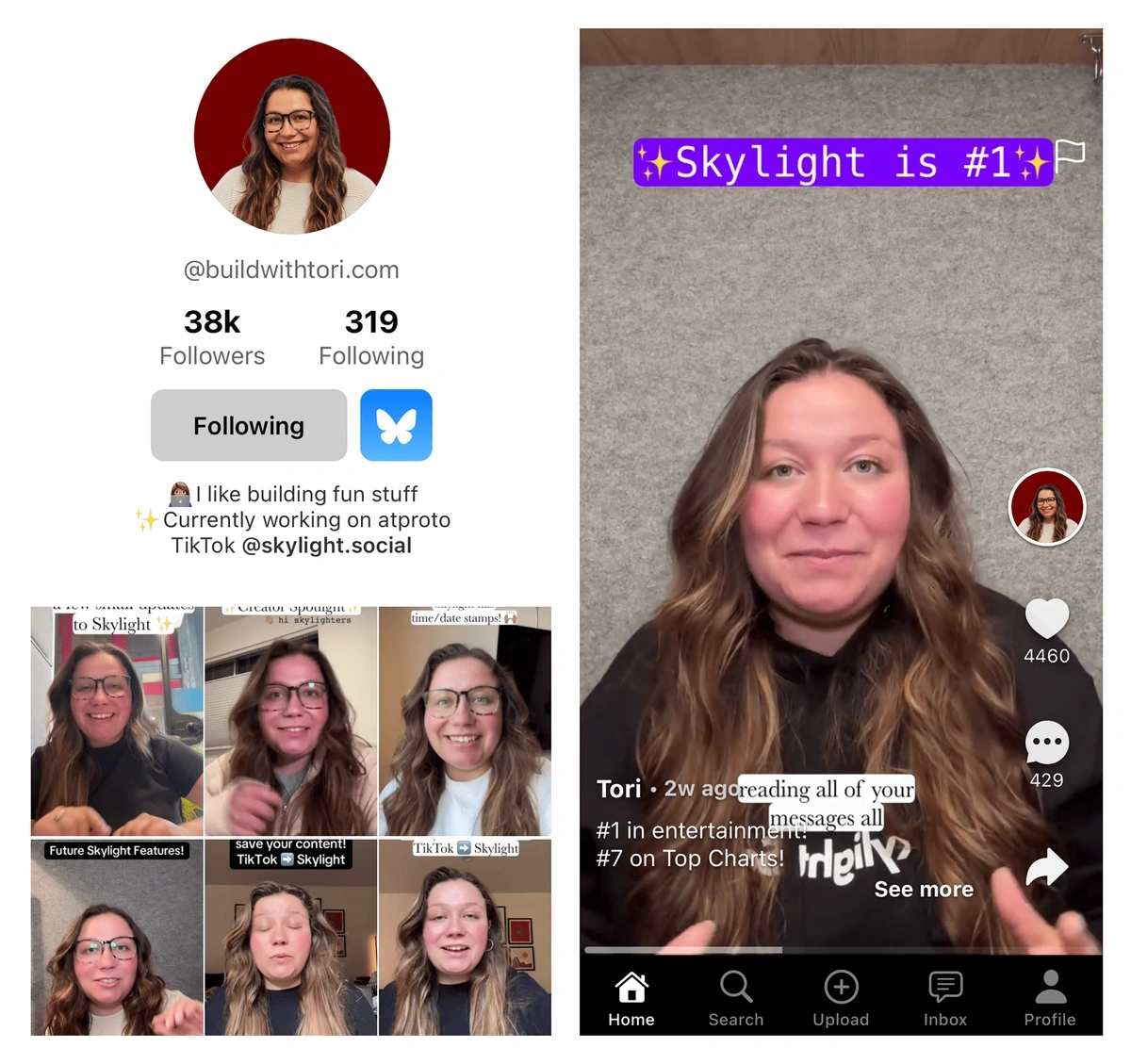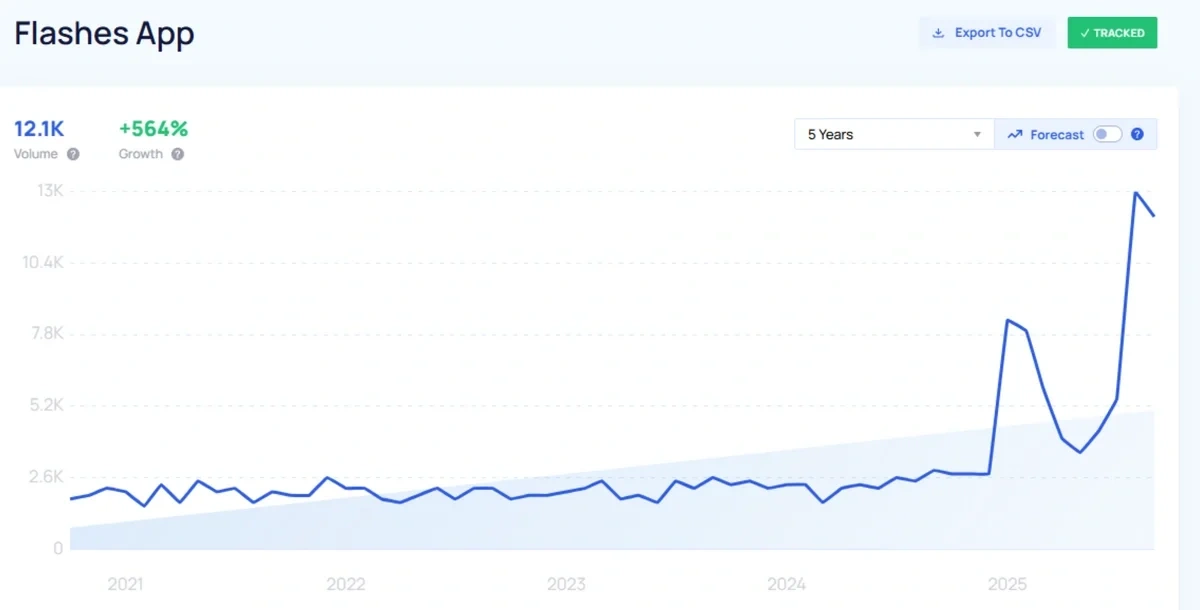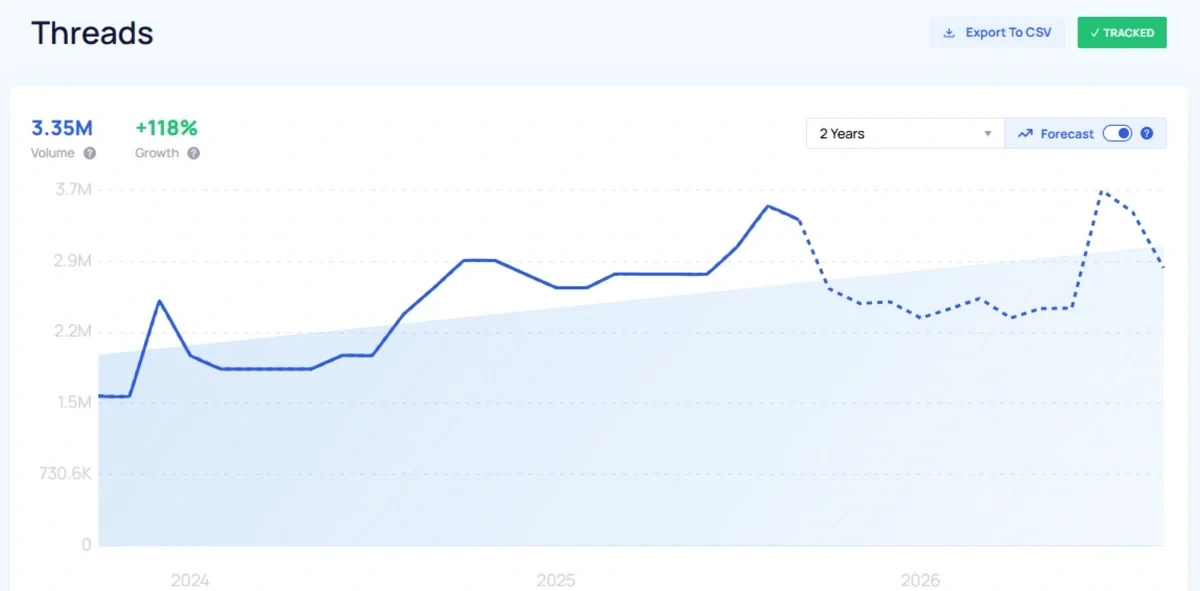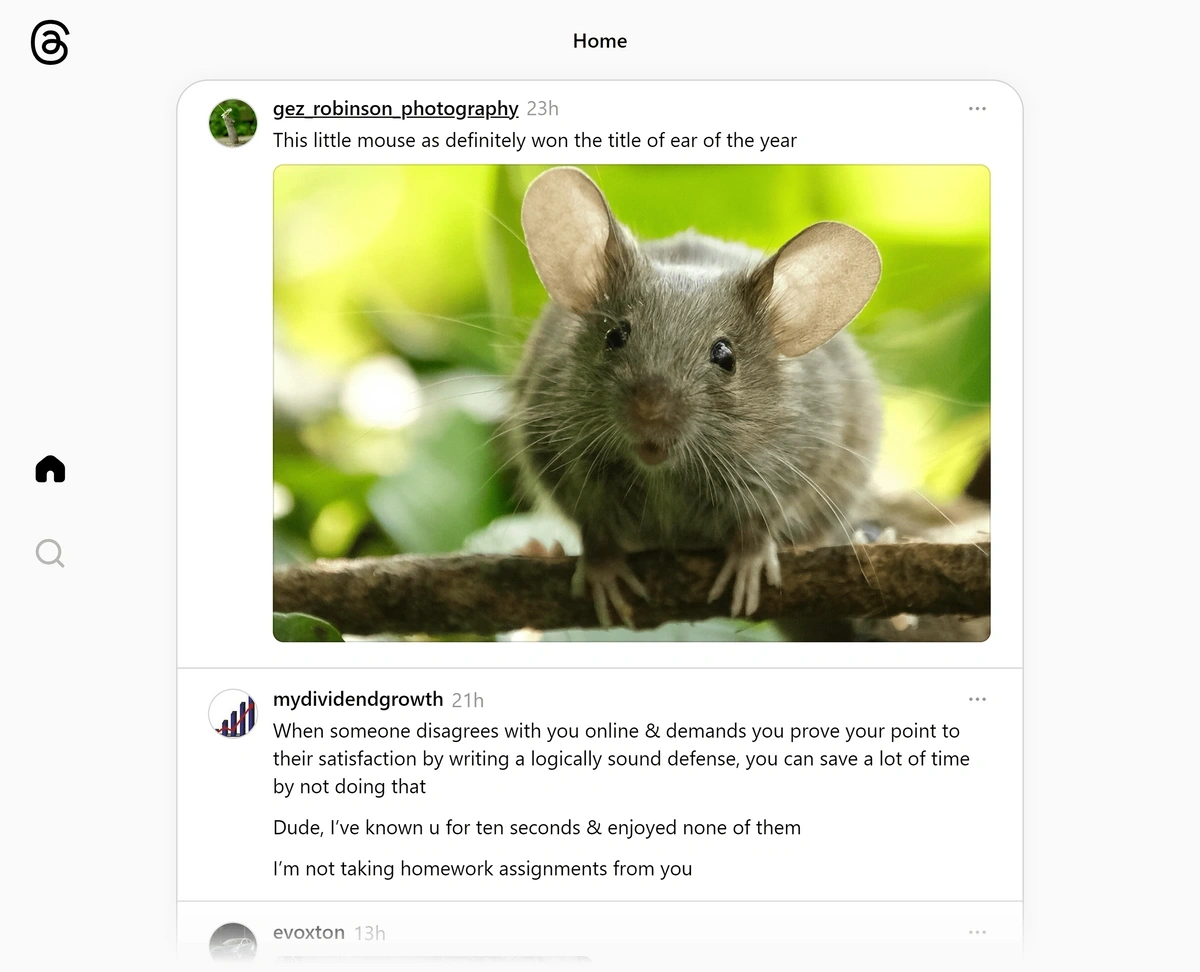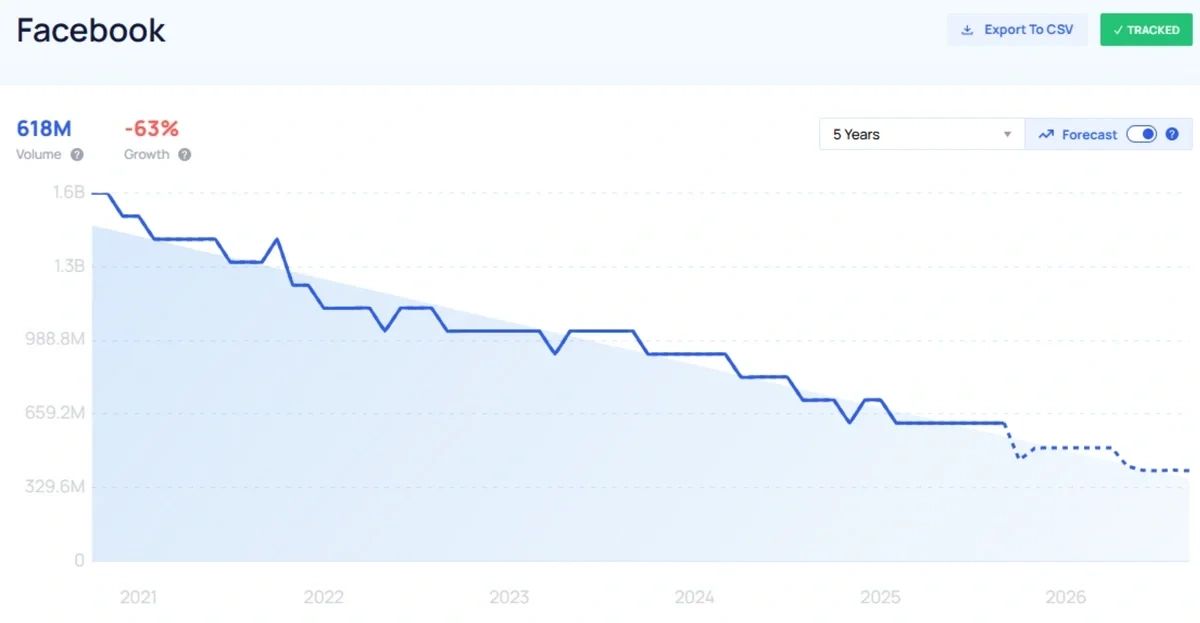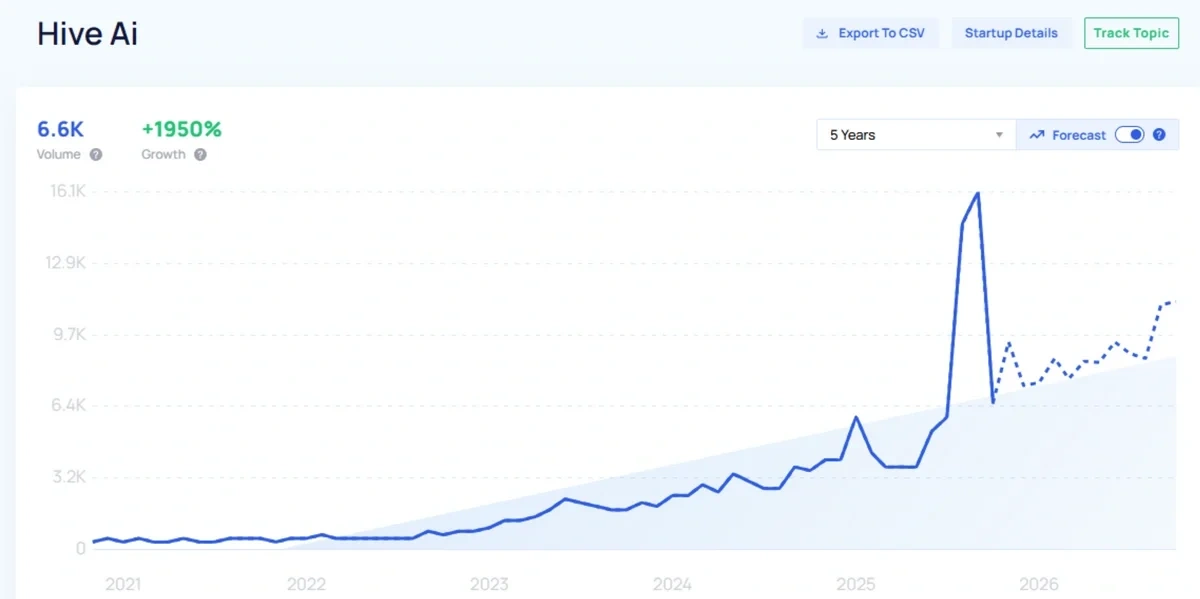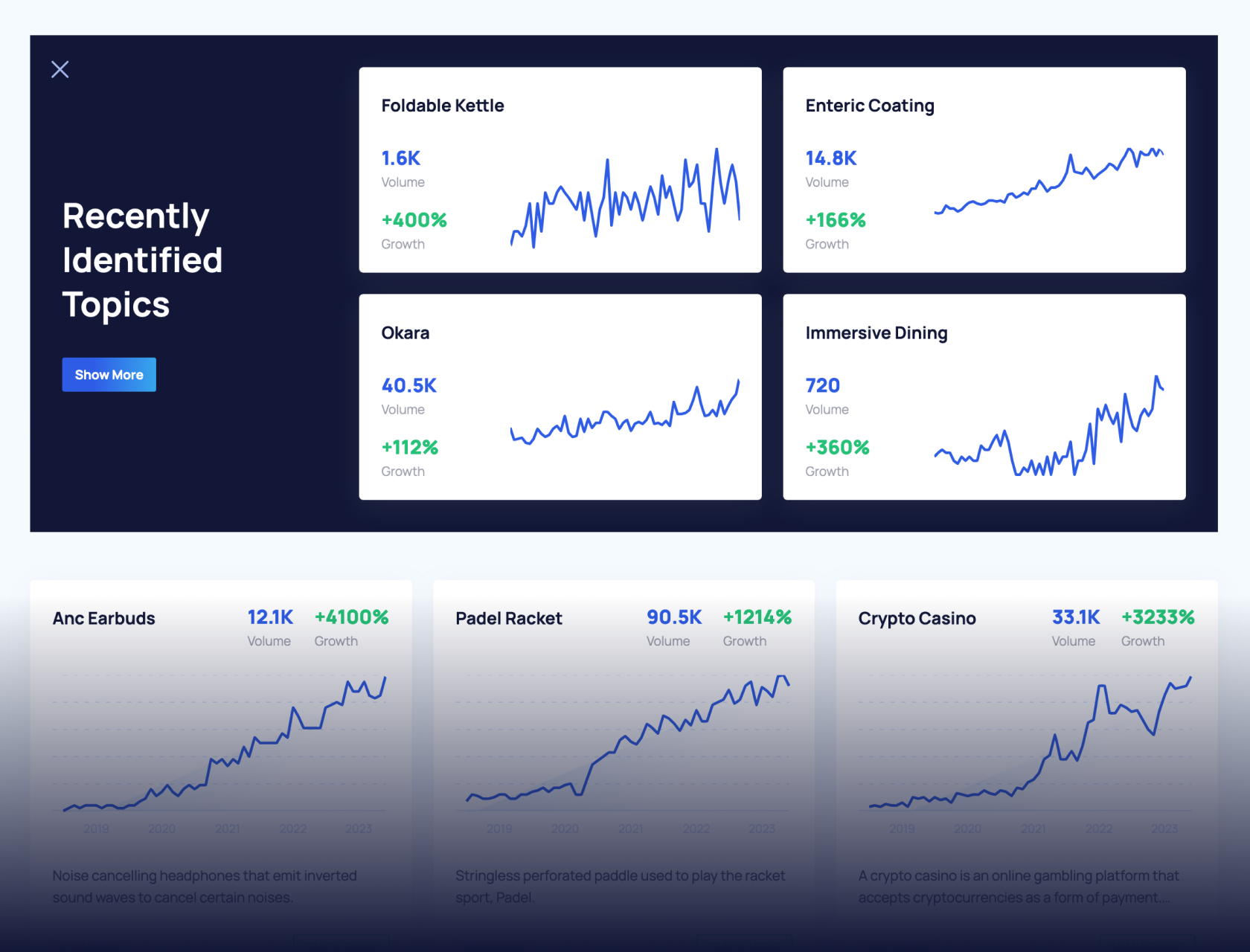
Decentralized social media: platforms, users, stats
Decentralized social media operates on independently run servers. It reduces the power and control that traditional platform owners have over both users and content.
Exploding Topics data shows search interest in decentralized social media has more than doubled in the last 5 years amid rising dissatisfaction with platforms like Facebook, Instagram, and X.
“Decentralized social media” searches have risen 145% in the last 5 years, with a positive forecast for 2026.
The average user now spends time on 6.75 social platforms per month. This suggests users are comfortable engaging with multiple platforms simultaneously.
So new, decentralized platforms don’t need to dethrone these established giants to build up their own user bases. They simply need to build critical mass.
With users leaving X in their droves, and a deal to keep TikTok operational in the US still not fully completed, conditions have rarely been better for a massive shift in how we conceptualize and use social media.
Read on to find out about platforms like Bluesky, Mastodon, and Pixelfed, and the changes in the social media landscape that are allowing them to flourish.
What is decentralized social media?
Decentralized social media is an alternative ownership model for social media platforms. It shifts control away from individuals or tech giants and back toward users.
Rather than the network being hosted on a central collection of servers, decentralized platforms are hosted across a network. The servers in the network are managed by its participants.
Some social media platforms use the shared ActivityPub protocol. This allows users to share content from one network to another. This ecosystem is known as the Fediverse.
“Fediverse” occasionally gets some big search spikes when decentralized social media hits the news. Overall, searches are up 900% in the last 5 years.
The promise of decentralized social media is a series of platforms that are ultimately controlled by the users.
Meta’s unwanted pivot to virtual reality was Zuckerberg’s brainchild. Musk has made X his personal political plaything. The threat to TikTok comes from the US government.
Decentralized social networks are less susceptible to the whims of individuals and governments.
Let’s take a look at some of the emerging decentralized social media platforms.
Bluesky
Bluesky has achieved the most mainstream appeal of any decentralized social media network. It currently has approximately 40 million users.
“Bluesky” searches peaked at more than 20 million per month. They have settled down at more than 6 million.
Searches are down from a November 2024 spike, but Bluesky continues to add approximately 0.3 new users per second. And the Exploding Topics forecast suggests the platform will continue its overall upward trajectory over the next year.
Available on all Exploding Topics plans, the trend forecast uses a deep learning machine model. Trained on millions of data points, it has a backtested accuracy of 87%.
Bluesky launched on an invite-only basis in February 2023, and went fully public a year later. Users have created more than 2 billion posts on the platform.
It has been a major beneficiary of the exodus from X because it offers a user experience highly similar to pre-Musk Twitter. That shouldn’t be a surprise, given that it was developed by Twitter founder Jack Dorsey.
The Bluesky interface. Look familiar?
In fact, Bluesky was developed in parallel with Twitter, with the intention of one day moving Twitter onto a decentralized protocol. But following the takeover, Bluesky became entirely separate.
Dorsey has since left. But the Twitter legacy remains clear in the interface. And on Bluesky, users have far more power to customize their own feeds, rather than handing complete control to an algorithm. That makes the Bluesky experience more like Twitter when it first launched.
Algorithmic feeds can still be beneficial when it comes to content discovery. Just look at TikTok, which is built almost entirely around the “For You Page”.
And Bluesky allows users to choose from over 40,000 algorithmic feeds.
A custom Bluesky feed dedicated to Liverpool Football Club.
Users can also build their own custom feeds, although it’s not altogether simple for non-developers. Startup Graze recently raised a $1 million pre-seed round for software that makes the process easier.
Bluesky is not part of the “Fediverse”, the collection of interoperable decentralized networks built on ActivityPub. Instead, it uses its own AT Protocol.
However, that protocol is open-sourced. And in December 2024, a $1 million fund was announced for developers building on the AT Protocol, which could in time lead to the growth of a larger atproto ecosystem.
Bluesky CEO Jay Graber recently attended the ATmosphere Conference, held specifically for people developing on the AT Protocol.
“We met a lot of folks there building apps we didn’t know about,” Graber said. “There are private messengers, new moderation tools.
“The benefit to developers of an open ecosystem is that you don’t have to start from zero each time. You have 34.6 million users to tap into.”
That figure has since risen closer to 40 million.
Meanwhile, Bridgy Fed can act as an opt-in bridge between Bluesky and any decentralized networks using ActivityPub. In June, its makers announced Bounce, a service for carrying over followers from Bluesky to Mastodon.
Mastodon
Like Bluesky, Mastodon is popular with “Twitter refugees”. It has an estimated 9.8 million users, although only around 760,000 are monthly users.
The network is formed of over 9,500 different instances, each with their own rules and interfaces. Around 259,000 active users are on the Mastodon.social instance.
Mastodon.social is something of a showcase for the capabilities of the Fediverse. Its main feed looks like X or Bluesky, but it can display posts from different Mastodon instances, and even from non-Mastodon social media networks built on the ActivityPub protocol.
Users on one Mastodon instance can view posts from across other instances.
Truth Social, the go-to platform for President Trump, is built on Mastodon’s open-source code (although it did not initially disclose that, violating the license terms). It has around 6 million active users.
However, Truth Social is not an instance of Mastodon. It uses the same basic code, but it has been “forked” out of the Fediverse ecosystem.
Pixelfed
If Bluesky and Mastodon are decentralized alternatives to X, then Pixelfed is the decentralized version of Instagram.
Like Mastodon, it is built around the premise of separate servers with different rules and limits. It has 1,800 servers, with Pixelfed.social the primary one.
“Pixelfed” interest spiked massively in January.
Across all servers, Pixelfed has 904,000 users. More than 97 million photos and videos have been shared.
It is built on ActivityPub, meaning posts on Pixelfed can be viewed on Mastodon and vice versa.
Pixelfed looks a lot like Instagram.
The network’s increased visibility in January was ironically partly down to Meta’s apparent attempts to censor it; links to Pixelfed were blocked as spam when shared on Meta platforms.
Skylight Social
Skylight Social is a decentralized alternative to TikTok. Its creators invite you to “join the unbannable short-form video platform.”
(That's clearly a reference to TikTok, although there are numerous banned social media apps.)
“Skylight Social” is the latest decentralized social media platform to see search spikes.
Like Bluesky, Skylight Social runs on the AT Protocol. So users’ content and connections exist on the protocol rather than the platform.
Anyone joining Skylight will automatically be following all of their Bluesky connections and will see their contacts’ Bluesky videos in a TikTok-style feed.
Mark Cuban has backed Skylight with a pre-seed round. He had revealed in January that he wanted to see a TikTok alternative built on the AT Protocol.
Skylight Social received roughly 240,000 downloads between its April launch and late August. 100,000 videos were uploaded in that period.
Flashes
Flashes is another decentralized network built on the emerging AT Protocol.
“Flashes app” searches are rising rapidly.
It’s essentially the AT version of Pixelfed. In other words, it’s a decentralized Instagram alternative, but one that seamlessly connects with Bluesky rather than Mastodon and other ActivityPub instances.
At the moment, Flashes is only on the App Store. But a GoFundMe for an Android app has raised more than $11,200.
The developer of Flashes based it on one of his previous decentralized apps, Skeets. That was effectively an interface for Bluesky, but one which catered for iPad users and offered customized accessibility features.
Skeets was downloaded more than 30,000 times. That user base did not automatically port across, but Flashes has been able to market to those same users — while ultimately trying to tap into the 40 million people now in the AT ecosystem.
The Flashes app has already been downloaded over 100,000 times in its own right.
Is Threads decentralized?
Threads is not decentralized. However, it has begun to integrate into the Fediverse.
Threads users in over 100 countries can now opt in to Fediverse sharing, which allows for cross-sharing with Mastodon and other ActivityPub servers.
However, Threads is owned by Meta, and questions remain about how well Threads will integrate.
Threads has been even more successful than Bluesky and Mastodon in capturing departing X users. Launched via Instagram, the Meta product has amassed more than 400 million monthly active users.
“Threads” searches are up 118% in the last 2 years.
It is primarily text-based, with a 500-character limit. Users can also add photos and videos.
Threads is Meta’s answer to X.
How we got here: social media disruption
We are in an era of major change in social media usage, with politics interacting with tech at a much deeper level than ever before.
Meta’s fight to stay on top
For a long time, the same handful of sites had a stranglehold on the social media space. Half of them were owned by Meta.
Facebook, WhatsApp and Instagram still make up 3 of the top 4 when it comes to monthly active users (MAUs), with the other spot held by Google’s YouTube.
As recently as August 2025, Facebook received 9.7 billion monthly visits.
In 2024, Meta reported revenue of $164.5B. That was a 22% increase on the previous year.
So Facebook and Instagram are still behemoths, but that means they struggle to pivot as quickly as newer, fresher upstarts.
“Facebook” searches are down 63% in the last 5 years.
After all, the name “Meta” only came about as a result of Mark Zuckerberg’s big bet on the metaverse, an attempt to keep Facebook at the forefront of the social industry for years to come. That’s starting to look like a questionable decision.
Metaverse shopping, metaverse concerts and metaverse sports all made sense when they were first conceived during the pandemic, at a time when real-world counterparts were limited. But all have seen steep, near-identical downturns in search interest.
The idea of “metaverse shopping” has all but died out.
There has been a surge in the idea of social commerce. But it is TikTok which has managed to take a commanding lead on that front, with monthly US shopping revenues of over $1 billion.
Indeed, Instagram is locked in a battle for audiences with TikTok across the board. The Meta platform introduced Reels in a relatively successful attempt to keep pace with the competition, but it has lagged in a number of key metrics.
The average TikTok user in the US spends 43 hours and 53 minutes on the platform each month, whereas the average Instagram user spends just 11 hours and 2 minutes. It’s a similar story when it comes to engagement rates.
Meanwhile, TikTok is fighting its own battles, given the ongoing situation in the US. While Donald Trump says a deal is agreed, concerns have been raised about potential new owners being able to license use of the algorithm.
Want to Spy on Your Competition?
Explore competitors’ website traffic stats, discover growth points, and expand your market share.
The downfall of X (formerly Twitter)
It isn’t just the Meta properties that have paved the way for a restructuring of the social media landscape. In fact, arguably the most significant change recently has been the steep decline of X, formerly Twitter.
As of September 2024, X had lost approximately 20% of its US daily user base since Elon Musk acquired the platform in October 2022. In the UK, that exodus amounted to a third of all users.
X’s overall reported ad reach, a reasonable proxy for the total number of users, fell by 33 million over the last year alone. Those who remain on the platform are almost two-thirds male.
X has struggled since rebranding from Twitter.
Among the remaining users, the average time spent on the platform per month is just 28 minutes.
Even more worringly, only 17% of US teens are using X, down from 33% a decade ago.
And the experience for those who remain is now deeply politicized. Musk was for a time a member of President Trump’s cabinet, and his own posts are afforded significant visibility on the platform, even beyond his 225 million+ followers.
Meanwhile, a November 2024 study found that political abuse on X is global, widespread, and cross-partisan.
Moderating decentralized social media
Questions remain about whether decentralized social media networks are capable of moderating content effectively.
The federated nature of these networks is great from a free speech perspective.
But on the other side of the coin, centralized social media has more established mechanisms for flagging and removing content that has no place on the internet. AI solutions are also cropping up to improve the moderation process.
"Hive AI" has been adopted as a moderation tool by centralized social platforms including Reddit and BeReal.
Make no mistake: moderation is a moral duty. Complete freedom of speech on the internet might sound like a noble goal, but the reality is different.
In a 2023 study by the Stanford Internet Observatory, analysis of 325,000 posts in the Fediverse over 2 days found that over 1,200 contained text relating to child grooming or explicit underage content.
Often, moderation is also a legal duty. So decentralized social media platforms need to find ways of effectively moderating user content.
Bluesky’s moderation system somewhat resembles that of a centralized social media network. There are community guidelines, and moderators are in place to review any content that is flagged or reported.
Amid the growing user base, Bluesky planned last November to quadruple the size of its moderation team to 100. It received 6.48 million user reports in 2024.
It has also developed an open-source “stackable” moderation system. This allows individuals and groups to apply filters which go beyond the default.
In September 2025, Bluesky announced plans to increase its enforcement efforts.
Mastodon relies on its system of individual servers, leaving moderation decisions to administrators and moderators on a local basis. But given that the largest server has hundreds of thousands of users, the idea of local moderation being best has faced challenges of scale.
Stay on top of decentralized social media
As a brand or a marketer, it’s crucial to move with your audience. If more people are exploring decentralized social media, you need to be doing the same.
Fortunately, you can start building your presence today with the Semrush social media toolkit.
Sign up now to access 100+ daily content ideas, social media analytics, and a lot more besides.
And add Exploding Topics Pro to really stay on the pulse.
You'll get weekly emails with curated lists of early-stage trending products and startups.
And access to our vast database of topics, with full search data.
Stop Guessing, Start Growing 🚀
Use real-time topic data to create content that resonates and brings results.
Exploding Topics is owned by Semrush. Our mission is to provide accurate data and expert insights on emerging trends. Unless otherwise noted, this page’s content was written by either an employee or a paid contractor of Semrush Inc.
Share
Newsletter Signup
By clicking “Subscribe” you agree to Semrush Privacy Policy and consent to Semrush using your contact data for newsletter purposes
Written By


James is a Journalist at Exploding Topics. After graduating from the University of Oxford with a degree in Law, he completed a... Read more

